Spirit: Focus on Indigenous Art, Artists, and Issues: Pat Kane

A group elders pull up to shore on Ekali Lake, near the small community of Jean Marie River, NWT. The area is rich in history – archeologists have uncovered many signs that this particular spot was an important meeting place (stone knives, buried fire pits and tools have been found here.) ©Pat Kane
This week we partner with the National Center for Civil and Human Rights to share the work of Indigenous Artists. As written by our curator, Donna Garcia: “this initiative should educate the public, through lens-based art, regarding the true history of indigenous people and recruit allies/advocates for indigenous issues everywhere, but with a specific focus on the US and Canada, where native lands and people аre still coming under attack everyday.”
Pat Kane is a documentary photographer whose work illuminates Indigenous life in Yellowknife, Northwest Territories. His work focuses on the people, their customs and the environments of remote northern Canada. Since the fall of 2015, Pat has been working with various NGOs and First Nations in the Northwest Territories to document Indigenous-led conservation programs, elder and youth camps, and tourism initiatives in these small, remote communities.
Kane’s goal is to show us that conservation is more than protecting land and animals; it is also about protecting Indigenous culture, identity and customs.
In small, remote communities in Canada’s Northwest Territories, people are getting back to the land as a way to create jobs, bridge the gap between elders and youth and cope with intergenerational trauma wrought by residential schools and other manifestations of colonialism.
Frank Hope, a Dene counselor and motivational speaker, says that being on the land is a spiritual experience; “This is a continual renewal and relearning to be like our ancestors who were resilient in surviving — and thriving — on the land,” he says.
The artist takes a documentary approach to the stories impacting Northerners, with a special focus on Indigenous issues and empowerment. He approaches his subjects with respect and empathy, giving people a collaborative sense to the photo making process and creating a visual syntax that is sensitive and intimate.
Kane vacillates between simply observing and actively interpreting scenes before his camera. He is a storyteller, considering ideas in shots calculated to invite the viewer’s participation. His work commences from life and has a dreamlike quality at times that lends a lyrical quality to the work. Not only does the artist spend extended time with his subjects, he also tends to stay in contact with them over long periods of time creating personal relationships and photographs that avoid clichés by emphasizing personal interactions.
The importance of mentorship for people in Northern communities is paramount for Pat. He offers training opportunities to promising photographers living North of 60, encouraging those interested in photography to assist or shadow his various assignments. He’s the co-founder and president of the Far North Photo Festival, which is a platform to help elevate the work of photographers in underrepresented parts of northern Canada.
Pat Kane is in support of The Kiwetin School on the Timiskaming First Nation (Quebec) and/or Dene Nahjo in Yellowknife (Northwest Territories): https://kiwetinschool.ca/ and https://www.denenahjo.com/

Melaw Nakeh’ko and Angela Code on the shoreline near a camp outside of Lutsel’ke, Northwest Territories. The women are part of a moose hide tanning camp where community members gather to learn the process of tanning hides for clothing. Nakeh’ko is a member of Dene Nahjo, an organization of young leaders looking to advance social and environmental rights for indigenous people in the NWT. Their motto is “Land, Language and Culture Forever.” ©Pat Kane
Guardians of the North
In small, remote communities in Canada’s Northwest Territories, people are getting back to the land as a way to create jobs, bridge the gap between elders and youth and cope with intergenerational trauma wrought by residential schools and other manifestations of colonialism. Frank Hope, a Dene counsellor and motivational speaker, says that being on the land is a spiritual experience. “This is a continual renewal and relearning to be like our ancestors who were resilient in surviving — and thriving — on the land,” he says. Since the fall of 2015, I’ve been working with various NGOs and First Nations in the Northwest Territories to photograph Indigenous-led conservation programs, elder and youth camps and tourism initiatives in small, remote communities. The goal is to show that conservation is more than protecting land and animals; it is about protecting indigenous culture and identity.

Presley Simba-Canadien comes face to face with the realities of harvesting wild food. With grocery prices so high, meat like this a cheaper (and healthier) alternative. Meat is often shared throughout the communities and the hunting of it is a way to keep cultures and traditions strong for future generations. ©Pat Kane
Pat Kane is a photographer in Yellowknife, Northwest Territories. He covers people, life and environment in northern Canada. Pat takes a documentary approach to the stories impacting Northerners, with a special focus on Indigenous issues and empowerment. He approaches his subjects with respect and empathy, giving people a collaborative sense to the photo making process and creating visual stories that are expressive and intimate. Pat values the importance of mentorship for people in Northern communities. He’s offered free year-long training opportunities to promising photographers living North of 60, and encourages those interested in photography to assist or shadow various assignments. He’s the co-founder and president of the Far North Photo Festival — a platform to help elevate the work of photographers in underrepresented parts of northern Canada. He’s also part of the photo collectives Natives Photograph and Boreal Collective, and is a 2020 World Press Photo Joop Swart Masterclass Participant. Pat identifies as mixed Indigenous/settler and is a proud Algonquin Anishinaabe member of the Timiskaming First Nation (Quebec).
Instagram: patkanephoto
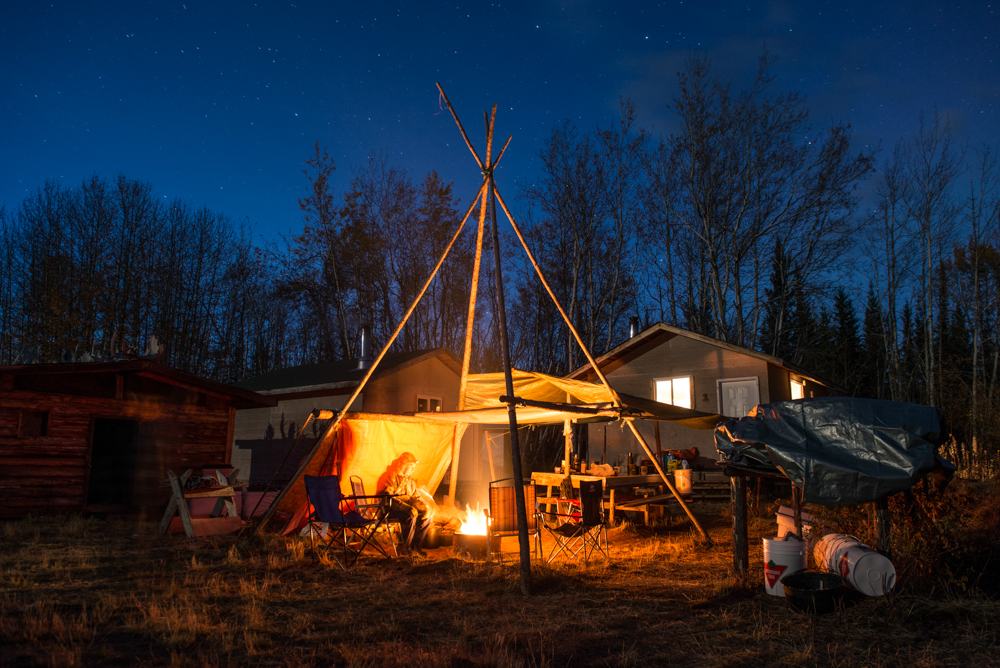
George Simba sits by the fire at the Tathlina Lake hunting camp, near Kakisa, Northwest Territories. He’ll hunt one moose on this trip, where in previous years he’s hunted a dozen or more. People in the community say resource development and the impacts of climate change, namely forest fires and drought, are pushing the wildlife out. ©Pat Kane

One of the staple foods in the Northwest Territories, no matter where you are, is fish. Here, a whitefish is chucked into a bin to be cooked over a fire at a camp near Lutsel K’e, Northwest Territories. The roe and head are particluar delicacies. ©Pat Kane
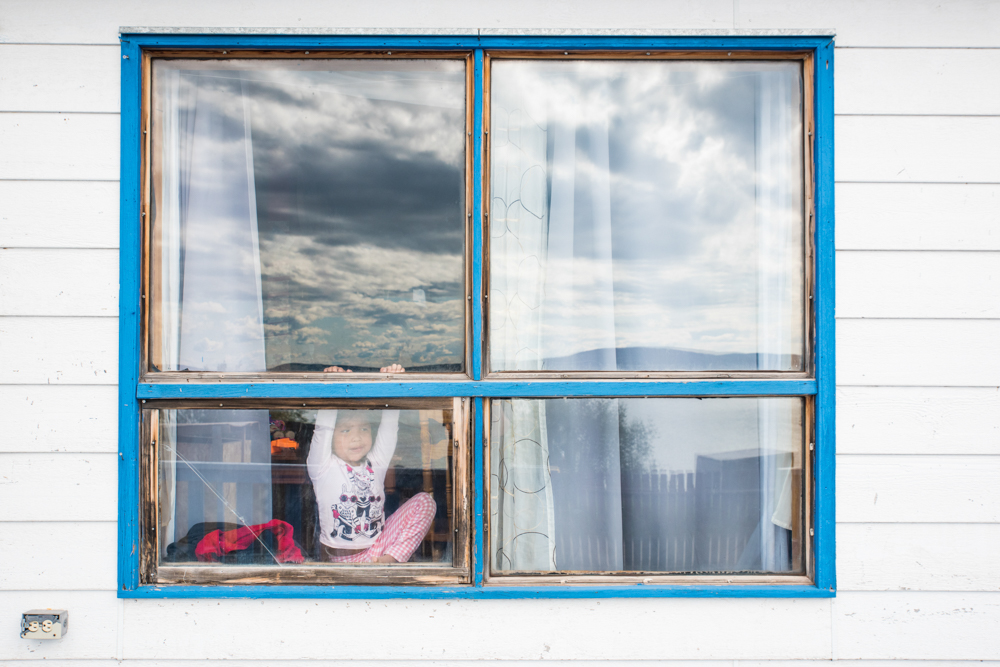
Dene First Nation hope that Thaidene Nene provides opportunities for their grandchildren through conservation initiatives and in preserving treaty rights like harvesting food for their families. ©Pat Kane
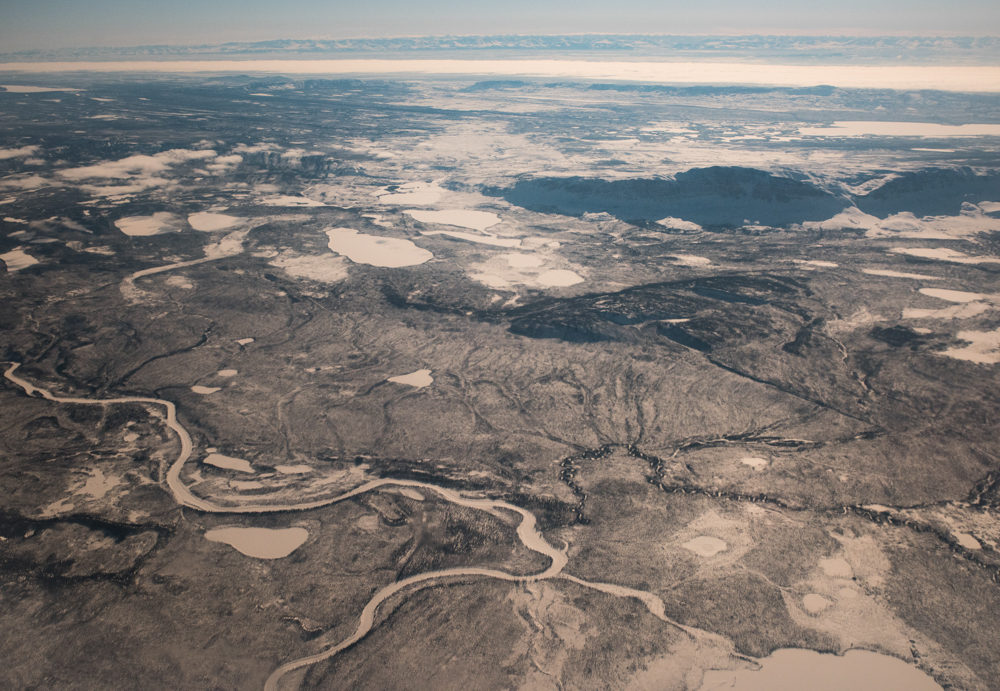
An aerial view near Fort Good Hope, Northwest Territories – a landscape that looks empty but is the source of resources and food for people who live nearby. ©Pat Kane

Lois Rabesca takes a break on a ski-do while scouting for moose and caribou in the Ts’udé Nilįné Tueyata protected area near Fort Good Hope, Northwest Territories. ©Pat Kane
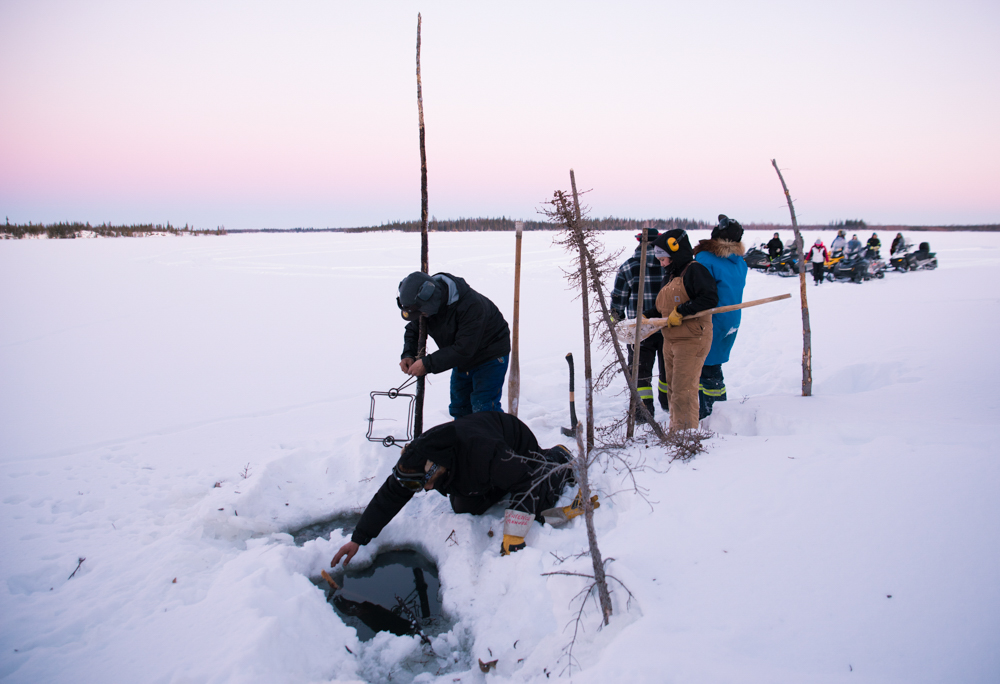
Trappers from Fort Good Hope, Northwest Territories, check a trap during a winter harvest. In recent years, the remote community has dealt with a vicious murder and sucide among its youth. To help cope, leaders and elders encourage residents to go back on the land as a community to relearn their traditions and heal together by working outside with each other. ©Pat Kane
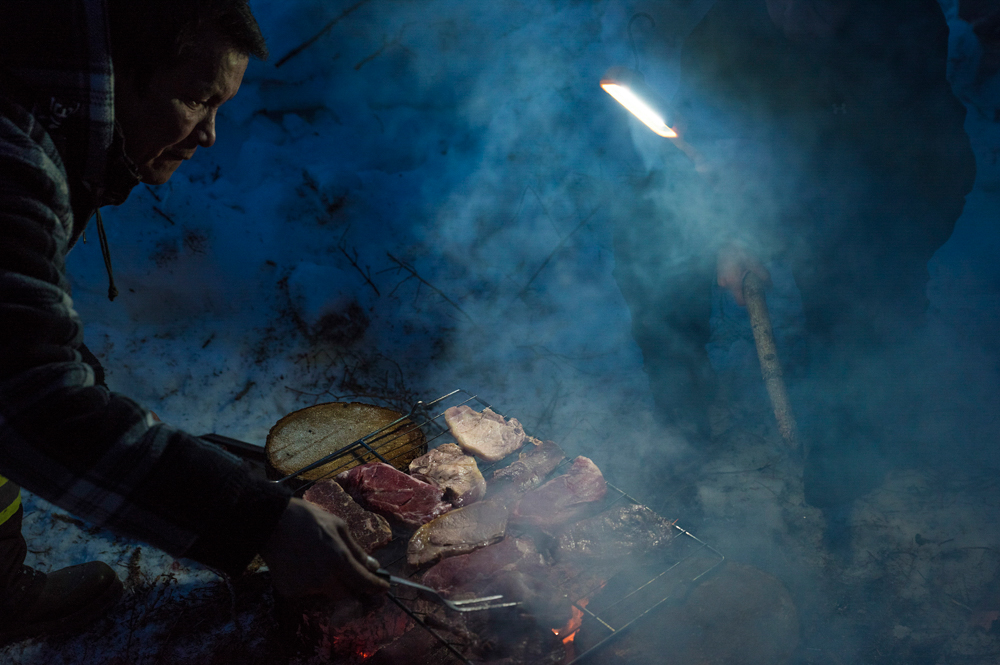
Floyd Kakfwi seasons fish and steaks on a campfire. After a long day of hunting, dinner is finally prepared. ©Pat Kane

Modeste Eddibar lights a cigarette in his cabin after fleshing out his wolf pelts in Colville Lake, Northwest Territories. With high costs of living in remote Northern communities, some people would rather earn a living from trapping then work at the oil and gas mines nearby, which they argue cause more harm to animals than trapping. ©Pat Kane
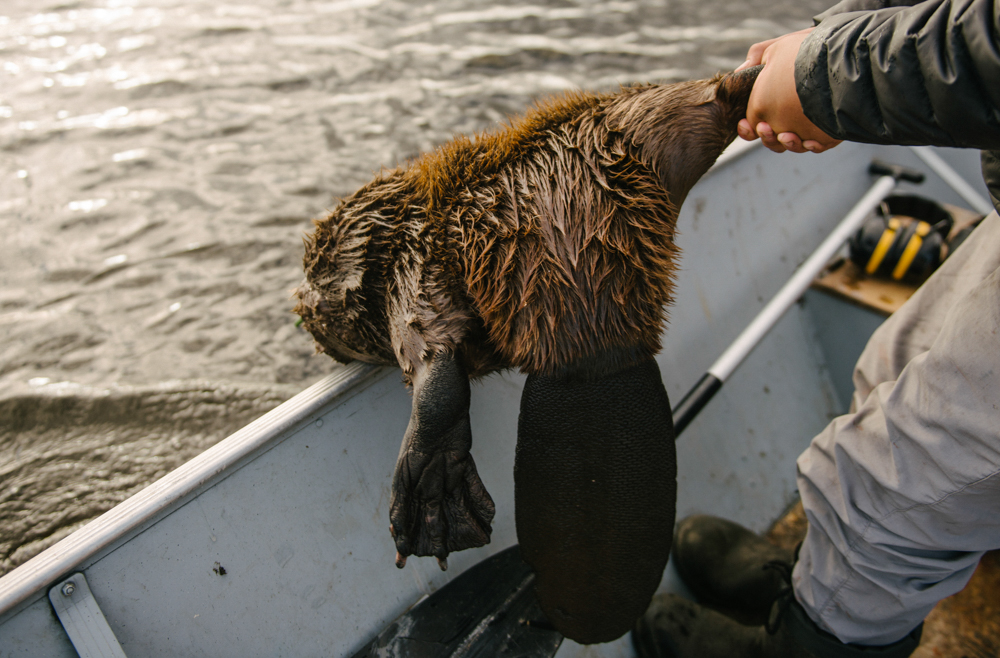
Tarek Chicot, a fourteen year-old hunter from Kakisa, Lake hauls a beaver into the boat. “I love being out here, it’s quiet and peaceful and no cops around. I learn a lot about the land from my grandpa and uncles”, he says. ©Pat Kane
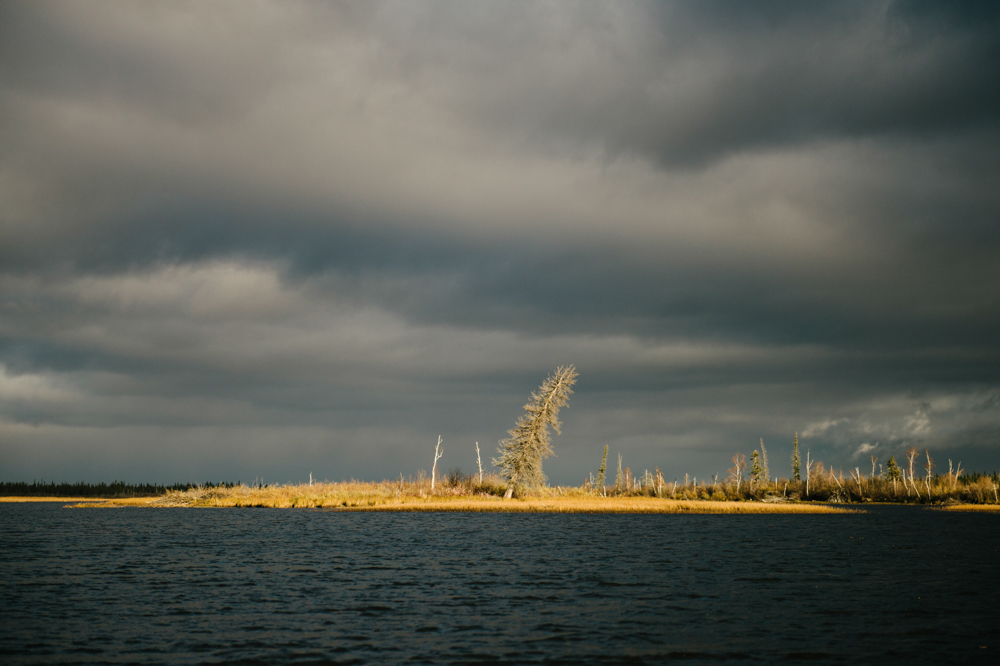
A spruce tree is lit by the sun peeking through storm clouds on Tathlina Lake, Northwest Territories. The tree acts as a navigational marker for people travelling by boat or skidoo, pointing the way around the small island to avoid rocks. The tree was tied to the ground when it was young and developed it’s lean as it grew. ©Pat Kane
About the Editor:
Donna Garcia’s work illustrate a semiotic dislocation that has been organically reconstructed in a way that gives her subjects a voice in the present moment; something they didn’t have in the past. Her images rise above what they actually are and become empathetic recreations in a fine art narrative. She has an MFA in Photography from Savannah College of Art and Design and her work has been exhibited internationally. She is a 2019 nominee of reGENERATION 4: The Challenges of Photography and the Museum of Tomorrow. Musee de l’Elysee, Lausanne, Switzerland. Emerging Artists to Watch, Fine Art Photography, Nomination (only 250 lens-based emerging artists nominated worldwide).
About the National Center for Civil and Human Rights:
The National Center for Civil and Human Rights is a cultural institution and advocacy organization located in downtown Atlanta, Georgia. Powerful and immersive exhibits tell the story of the American Civil Rights Movement and connect this history to modern struggles for human rights around the world. The National Center for Civil and Human Rights has the distinction of being one of the only places to permanently display the papers and artifacts of Dr. Martin Luther King, Jr. Events, educational programs, and campaign initiatives bring together communities and prominent thought leaders on rights issues. For more information, visit civilandhumanrights.org and equaldignity.org. Also sign up for Campaign for Equal Dignity!
Join the conversation on @ctr4chr (Twitter), @ctr4chr (Facebook), and @ctr4chr (Instagram).
Posts on Lenscratch may not be reproduced without the permission of the Lenscratch staff and the photographer.
Recommended
-
Andrew Lichtenstein: This Short Life: Photojournalism as Resistance and ConcernDecember 21st, 2025
-
Paccarik Orue: El MuquiDecember 9th, 2025
-
Lauri Gaffin: Moving Still: A Cinematic Life Frame-by-FrameDecember 4th, 2025
-
Dani Tranchesi: Ordinary MiraclesNovember 30th, 2025
-
Art of Documentary Photography: Elliot RossOctober 30th, 2025
























































